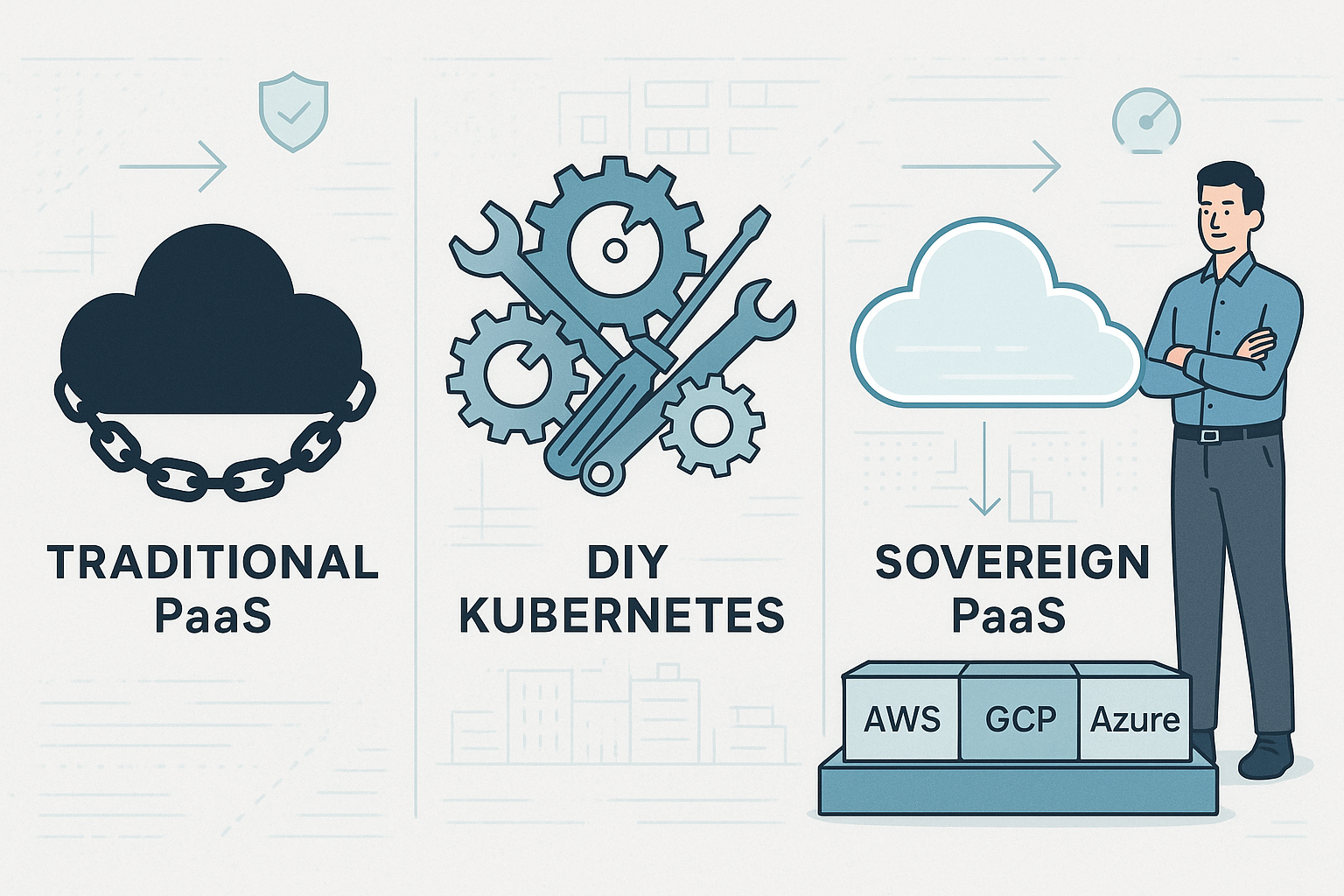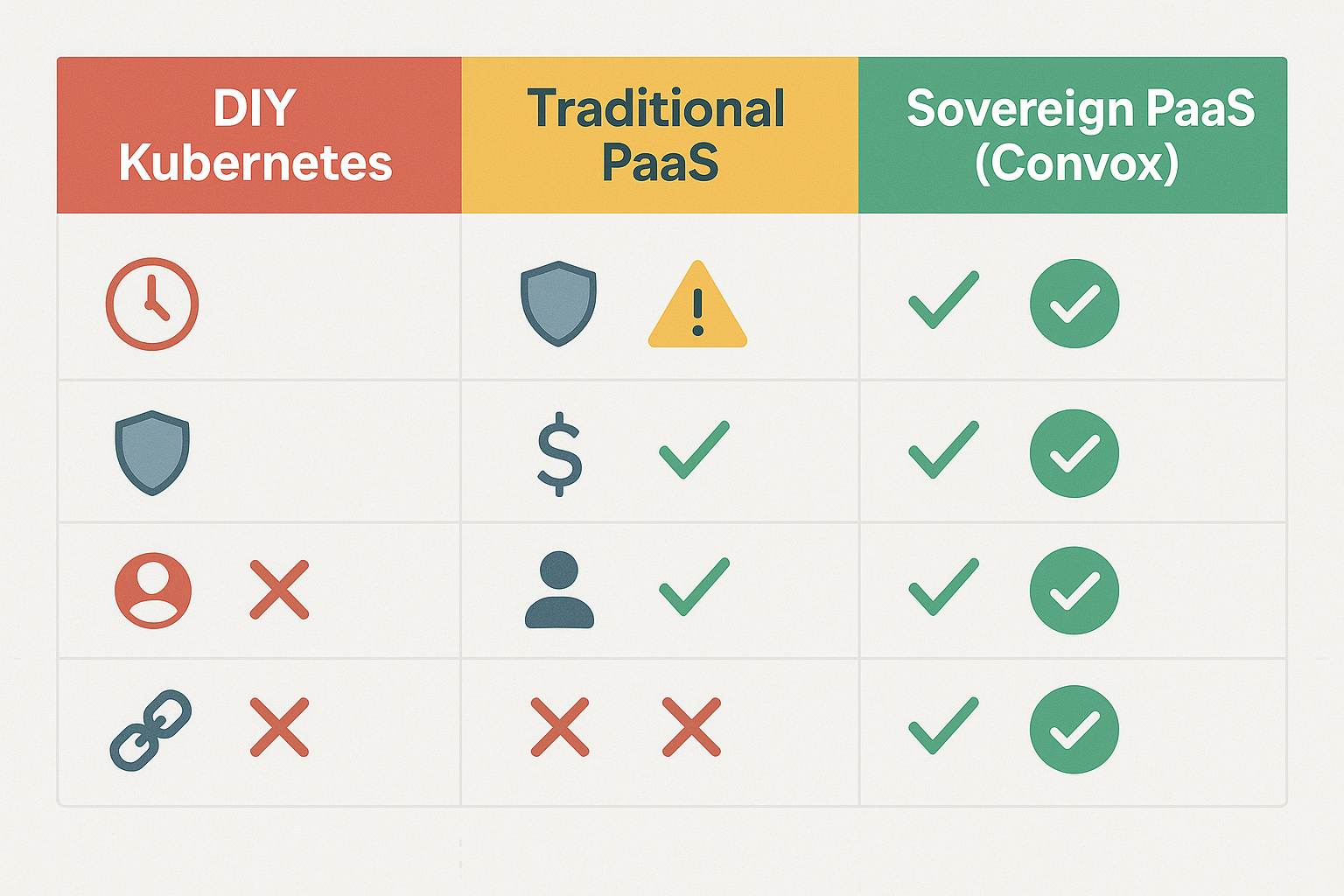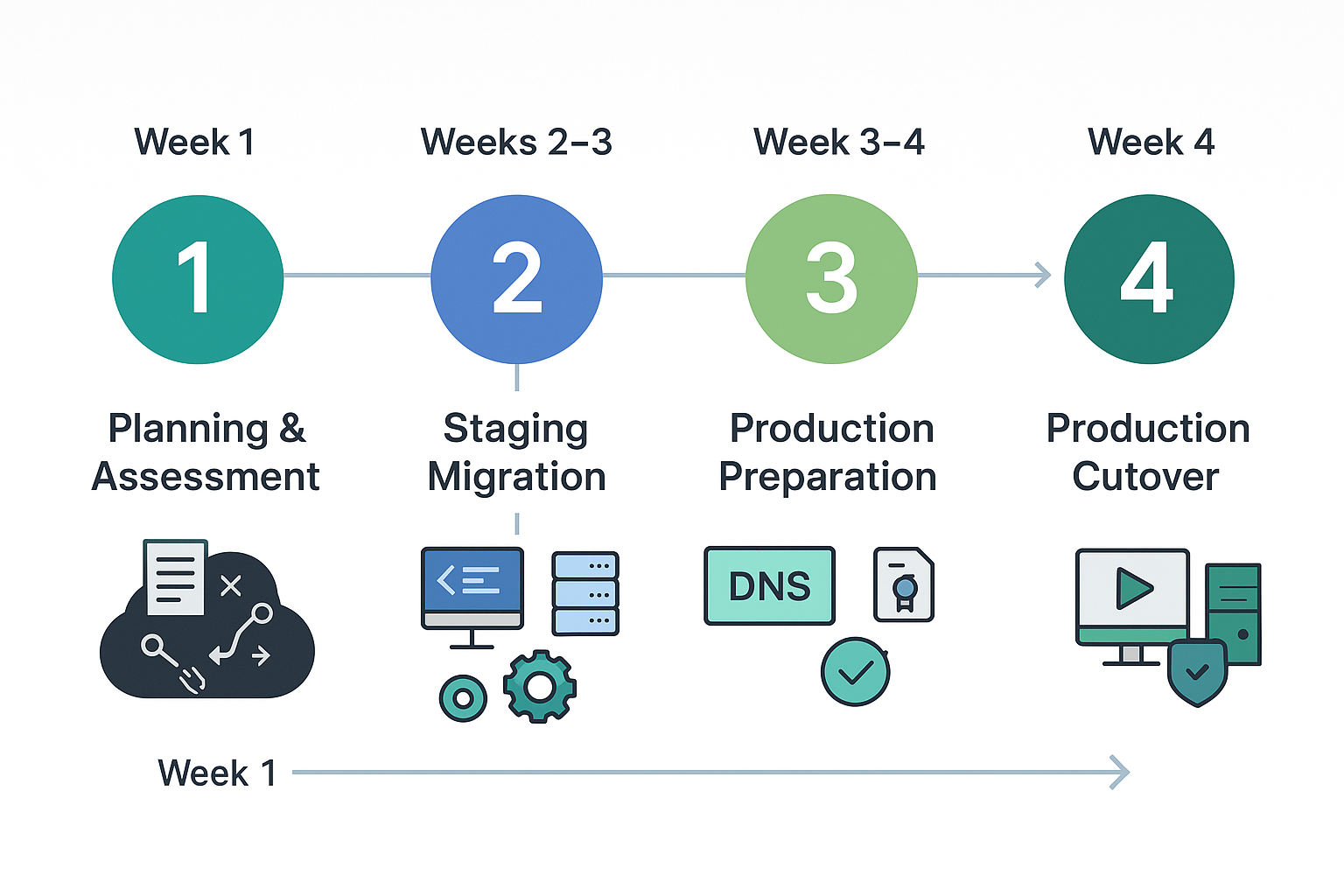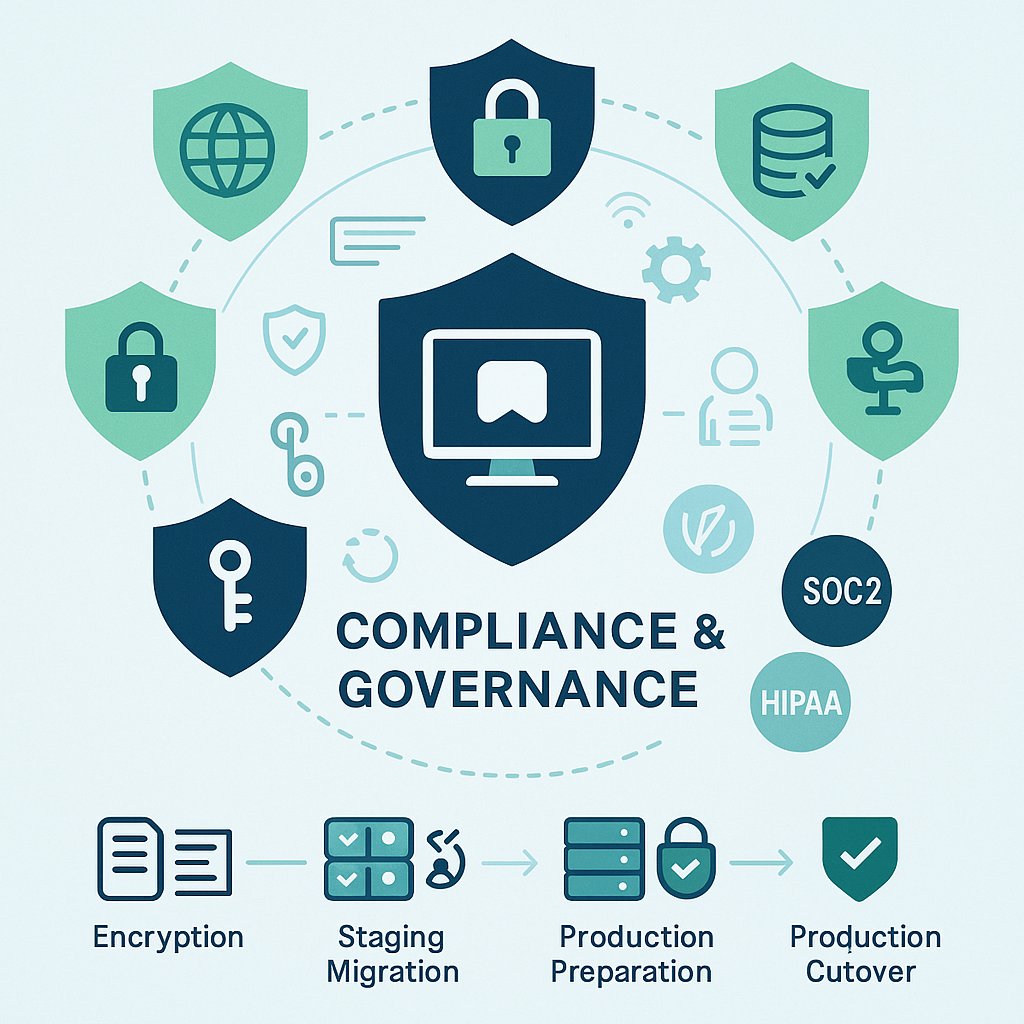
The cloud platform debate has evolved far beyond the traditional binary choice of "build it yourself" or "buy a Platform-as-a-Service." In 2025, forward-thinking engineering teams face a more nuanced question: How do we maintain velocity without sacrificing control or compliance?
With the continued growth of Platform-as-a-Service adoption and increasing emphasis on data sovereignty controls, the stakes have never been higher. Teams are under pressure to move fast, stay secure, and control costs—all while navigating an increasingly complex regulatory landscape.
The answer isn't choosing between speed and sovereignty. It's finding the middle path: Sovereign PaaS.
Solutions like Heroku, Render, Railway, and Vercel have been game-changers for developer velocity. They remove infrastructure headaches and help teams move fast with minimal setup. For prototyping and early-stage development, they're excellent choices.
But as businesses mature, the true costs emerge:
When your data lives outside your cloud account, meeting regulatory requirements becomes significantly more complex. Consider these scenarios:
With businesses increasingly prioritizing public cloud solutions for security and compliance benefits, traditional PaaS offerings may fall short. Your data might be processed across multiple jurisdictions without your knowledge, creating compliance risks that are difficult to identify and manage.
On the opposite end, building your own platform with Kubernetes gives you ultimate control—but at what cost?
To replicate a PaaS experience, you need to implement:
Reality Check: Enterprise Kubernetes implementations typically require significant initial setup time and ongoing maintenance resources.
Enter Sovereign PaaS—a paradigm that delivers Heroku-like simplicity while keeping you in complete control of your infrastructure, data, and compliance posture.
With Convox's sovereign PaaS approach, you get:
# Simple convox.yml - Deploy with one command
environment:
- DATABASE_URL
services:
web:
build: .
port: 3000
scale:
count: 2-10
targets:
cpu: 70
worker:
build: .
command: bundle exec sidekiq
scale:
count: 1-5
resources:
database:
type: postgres
options:
storage: 100This simple manifest deploys a production-ready application with:
But unlike traditional PaaS, everything runs in your own AWS/GCP/Azure account.
Let's see how a typical migration looks. Here's a company moving from Heroku to Convox:
Before (Heroku):
# Limited control, shared infrastructure
heroku ps:scale web=3
heroku addons:create heroku-postgresql:standard-0
# Data lives in Heroku's infrastructure
# No VPC control, limited compliance optionsAfter (Convox):
# Full control in your AWS account
services:
web:
build: .
port: 3000
scale:
count: 2-10
targets:
cpu: 70
health:
path: /health
timeout: 30
resources:
database:
type: rds-postgres
options:
class: db.t3.large
storage: 100
encrypted: true
deletionProtection: true# Deploy with full infrastructure control
convox deploy
# Result: Everything in your VPC, your encryption keys, your audit logsThe result? The same developer experience, but with:


| Factor | DIY Kubernetes | Traditional PaaS | Sovereign PaaS (Convox) |
|---|---|---|---|
| Time to Production | 3-6 months | 1 day | 1 day |
| Data Residency | Full control | Zero control | Full control |
| Compliance Readiness | Complex setup | Limited options | Built-in tools |
| Customization | Unlimited | Severely limited | High flexibility |
| Cost Predictability | Variable | Poor at scale | Excellent |
| Team Expertise Required | Kubernetes experts | Minimal | Standard developers |
| Vendor Lock-in Risk | None | High | Low |
Challenge: A digital health platform faced a compliance audit that revealed they couldn't demonstrate proper data controls or provide the audit trails required for HIPAA compliance.
Solution with Convox:
# HIPAA-compliant deployment
services:
api:
build: .
port: 8080
internal: true # Not publicly accessible
health:
path: /health
environment:
- ENCRYPTION_KEY
resources:
database:
type: rds-postgres
options:
encrypted: true
backupRetentionPeriod: 30
deletionProtection: trueResult:
Challenge: A payments company hit scaling limitations and faced escalating costs that made their traditional PaaS solution unsustainable.
Convox Implementation:
services:
api:
build: .
port: 3000
scale:
count: 5-50
targets:
cpu: 60
memory: 80
worker:
build: .
command: npm run worker
scale:
count: 2-20
targets:
external:
- name: "sqs-queue-depth"
averageValue: 100
balancers:
api-lb:
service: api
ports:
443: 3000Results:
For a typical growing SaaS company with moderate scale requirements:
Traditional PaaS: Costs can escalate unpredictably as you scale, with limited control over infrastructure expenses and potential vendor lock-in creating migration costs.
DIY Kubernetes: Requires significant upfront investment in expertise and ongoing operational overhead, with infrastructure costs plus substantial engineering time.
Sovereign PaaS (Convox): Provides predictable costs with infrastructure transparency, minimal operational overhead, and no vendor lock-in risks.
Beyond direct costs, Sovereign PaaS provides quantifiable risk mitigation:

Following the Heroku Migration Guide, start with a simple configuration:
# Basic convox.yml for migration testing
environment:
- DATABASE_URL
services:
web:
build: .
port: 3000
scale:
count: 2
resources:
database:
type: postgres
options:
storage: 20Key migration steps:
convox apps create myapp-stagingconvox deployconvox resources proxy databaseconvox certs generate yourdomain.comconvox env setFollowing Convox's proven migration process:
convox deploy --waitPro Tip: Convox offers migration assistance for teams who want expert guidance through this process. Our engineers can help with the entire migration, from planning to cutover, ensuring optimal configuration.
Convox includes compliance-ready features out of the box that deploy in your own cloud account:
# Production-ready secure configuration
services:
web:
build: .
port: 3000
environment:
- ENCRYPTION_KEY
health:
path: /health
timeout: 30
resources:
database:
type: rds-postgres
options:
encrypted: true
backupRetentionPeriod: 30
deletionProtection: trueThis automatically provides:

The Convox Console provides enterprise-grade governance features:
Comprehensive Audit Logs: Every action taken in your Convox console is logged and auditable, including:
Granular RBAC (Role-Based Access Control): Fine-tune access across your organization with:
This granular permission system ensures that team members have exactly the access they need while maintaining complete audit trails for compliance purposes.
For global operations, Convox makes multi-region compliance straightforward through the Console:
Setting up regional deployments:
# Same application config works across regions
services:
web:
build: .
port: 3000
resources:
database:
type: rds-postgres
options:
encrypted: trueEach regional rack operates independently with full data sovereignty, making it straightforward to comply with regulations like GDPR (EU data stays in EU) while using the same application configuration across all regions.
Go beyond basic CPU scaling with business-specific metrics:
services:
processor:
build: .
scale:
count: 2-50
targets:
external:
- name: "datadog@default:queue-depth"
averageValue: 100
- name: "datadog@default:error-rate"
averageValue: 5Deploy complex microservice architectures with ease:
services:
api:
build: ./api
port: 3000
internal: true
web:
build: ./web
port: 8080
environment:
- API_URL=http://api.myapp.convox.local:3000
worker:
build: ./worker
command: bundle exec sidekiq
scale:
count: 1-10
resources:
database:
type: rds-postgres
cache:
type: redisDeploy GPU-enabled services for AI workloads using Convox's scaling capabilities:
services:
ml-inference:
build: .
command: python serve_model.py
scale:
count: 1-5
cpu: 1000
memory: 4096
gpu: 1 # Request 1 GPU per process
targets:
cpu: 80Prerequisites for GPU scaling:
convox rack params set nvidia_device_plugin_enable=trueThis configuration automatically handles GPU allocation and scaling based on demand, perfect for ML inference services that need to scale during peak processing times.
The question in 2025 isn't whether to use the cloud—it's how to use it strategically. Traditional PaaS solutions trade away too much control for convenience, while DIY approaches consume too many resources for uncertain returns.
Sovereign PaaS represents the evolution of cloud platforms: delivering the developer experience teams love while maintaining the control and compliance businesses require.
✅ Deploy in minutes, not months - Simple convox.yml configuration
✅ Your infrastructure, your rules - Everything runs in your AWS/GCP/Azure account
✅ Compliance-ready from day one - Built-in support for regulatory requirements
✅ Transparent, predictable costs - Pay your cloud provider directly
✅ No vendor lock-in - Standard Docker containers and cloud resources
✅ Enterprise-grade scaling - Auto-scaling, load balancing, zero-downtime deploys
The market is maturing beyond the false choice between speed and sovereignty. Leading engineering teams are choosing platforms that deliver both.
Get started with Convox today:
🚀 Register your free account - Deploy your first app in under 30 minutes
📚 Watch Convox Academy - Complete setup guides and video tutorials
💻 Primary Convox Repository - Quick Start Guide and other materials
💻 View code examples - Ready-to-deploy sample applications
✉️ Contact our team - Get personalized guidance for your use case and FREE migration assistance
The future of cloud platforms isn't about choosing between control and convenience—it's about having both.
